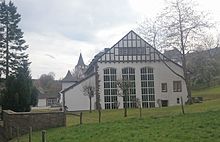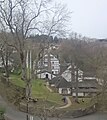Hermann Göring Master School for Painting
The Hermann Göring Master School for Painting in Kronenburg ( Eifel ), named after the leading National Socialist politician and Commander in Chief of the German Air Force at the time, Hermann Göring , was a master school for art painters built by the painter Werner Peiner . It was founded on March 23, 1936 by decree of the Minister for Art, Science and Public Education to form the "Landakademie Kronenburg der Staatliche Kunstakademie Düsseldorf". Under the direction of Peiner, professor at the Düsseldorf Art Academy since 1933 , it soon became independent. Its building was designed and built by the Düsseldorf architect Emil Fahrenkamp , and was inaugurated on June 9, 1938 by Hermann Göring. The facility was an important place for the National Socialist art and cultural policy to train painters who were supposed to create so-called blood and soil art in the sense of the National Socialist regime.
After the liberation from National Socialism in 1945, the school was not continued; Today the house is owned by the German state of North Rhine-Westphalia and is titled as "House for Teacher Training". In October 2016, an information board was attached to the building reminding of the Nazi history.
The learning content of the painting school was strongly oriented towards Werner Peiner's interests. The acceptance required a certificate of no objection, the ' Aryan ' ancestry and the sympathy of Werner Peiner, who was the final authority to make any decision at the Kronenburg. The execution of carpet cycles or similar monumental propagandistic work took place in a kind of “workshop relationship” in which a strict hierarchical order prevailed, i.e. the division of the students into apprentices, journeymen and masters. The 'leading master' wanted to raise a new leadership elite. Accordingly, the artistic concepts of Peiner, the “leading master”, were primarily or exclusively worked on. This fundamentally stood in the way of an education for individual creativity or intellectual independence. The work process was characterized by the dominance and art-historical preferences of Peiner.
The Hermann Göring Master School for Painters was the result of a fusion of National Socialist conceptions of art and the leadership principle that prevailed under National Socialism . It shows that its actors needed good relationships with functionaries of the Nazi regime or individual Nazi sponsors in order to be able to produce public art during this period. At the same time, the history of the Hermann Göring Master School for Painting shows the direct influence of individual NSDAP functionaries on the art style. This style cannot be understood as an expression of an ordinary epoch in which a multitude of social forces produced art and art forms under the conditions of free competition and open dialogue, but must be understood as the result of a work in which the totalitarian Nazi regime Leadership was to produce a treasure trove of forms for propaganda purposes.
Library
Nine precious medieval manuscripts that belonged to the master school are now kept by the Düsseldorf Art Academy . The manuscript (today: Ms. 2) of the Roman de la Rose , which can be viewed online, is one of them.
student
- Hans Lohbeck
- Wilhelm (Willi) Wewer
- Rolf Dettmann
- Kurt Otte
- Adolf Odenthal
- Hans Heinrich Adam
- Erich Feld
- Hans Zieher
- Peter Recker
- Baldur Nielsen
- Werner Regner
- Gudrun Irene Widmann
- Peter Langner
- Heinz Hindorf
- Herbert Rottmann
- Theo Busch
- Hans Teuschler
- Albert Meinhardt
- Willi Kerig
- Inge Stark
- Valentin Spielberg
- Karl Seidl
- Ralf Humbert
- Willi Sitte (later well-known GDR artist)
- Inge Felhuber
- Otfried Mahnke
- Joachim Böhmer
- Hildegard Urban
- Johanna Mootz
- Hannelore Heintze
- Klemens Siebeneichler
- Marianne Kupke
- Erika Hummel
- Mick Monse-Mahron
- Renate Baluschek
Pictures of the building
literature
- Anja Hesse: Painting of National Socialism. The painter Werner Peiner (1897–1984). Olms-Verlag, Hildesheim, 1995. (printed therein: “The spiritual law of the Hermann Göring master school for painting”) ISBN 3-487-09978-0 .
- Nikola Doll: Patronage and Art Promotion during National Socialism. Werner Peiner and Hermann Göring , VDG, Weimar 2010, ISBN 978-3-89739-703-3 (also dissertation: The Hermann Göring Master School for Painting. A study on patronage in National Socialism. Ruhr University Bochum, 2003).
- Hanns Christian Löhr: The Iron Collector: The Hermann Göring Collection - Art and Corruption in the “Third Reich”. Gebr. Mann Verlag, Berlin 2009, ISBN 978-3-7861-2601-0 . (especially chapter 3)
- Reinhard Müller-Mehlis: Art in the Third Reich. Heyne, 1976 ISBN 3-453-41173-0 .
- Berthold Hinz : Painting in German Fascism - Art and Counterrevolution. Hanser, Munich 1974, ISBN 3-446-11938-8 .
- Hermann Hinkel: On the function of the image in German fascism. Anabas, Steinbach 1975, ISBN 3-87038-033-0 .
- Georg Bussmann (Red.): Art in the 3rd Reich - documents of submission. Catalog of the Frankfurter Kunstverein, 1974, new edition by the publishing house 2001 in 1980.
- Conrad-Peter Joist: The Eifel in the picture of the Kronenburger school. In: Landschaftsmaler der Eifel, Düren 1997, ISBN 3-921805-12-0 .
- Dieter Pesch, Martin Pesch: Art in the Third Reich. Werner Peiner - seducer or seduced , Grin Verlag, Munich 2012.
Web links
Individual evidence
- ↑ Deutschlandfunk.de , September 15, 2014, Frank Möller, deutschlandfunk.de: Schwewiegen. Repressed. To forget? (Last accessed: April 18, 2015)
- ↑ http://www.fortbildung-kronenburg.nrw.de/index.php/tagungshaus/geschichte.html .
- ↑ a b Peiner, Werner; Interview. In: Kölnische Rundschau (Sunday supplement), November 21, 1937, pp. 11–12.
- ^ Doll, Nicola: Patronage and Art Promotion under National Socialism: Werner Peiner and Hermann Göring, Weimar, 2009.
- ↑ Handwriting Census Rhineland No. 416–424 ULB Düsseldorf . See the remarks by Gregor Weyer in: De la Rose: texte, image, fortune (2006), pp. 117f.
- ↑ http://romandelarose.org/#read;AB142.001r.tif .
Coordinates: 50 ° 22 ′ 3 ″ N , 6 ° 28 ′ 46 ″ E



